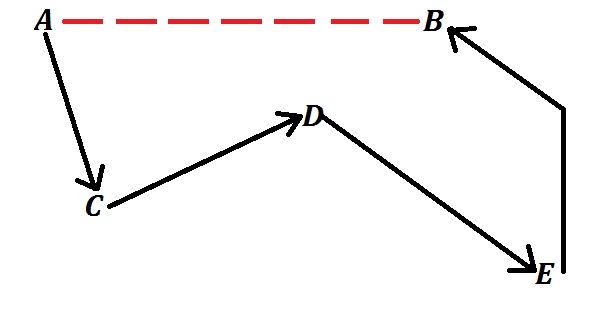Don’t do more than you need to do to reach your goal. And don’t do less . . .
What is the shortest distance between two points? Let’s say you’re at point A and you want to go to point B. The shortest way, of course, is a straight line. You don’t first go down to C and then over to D and, oh yeah, drop by E on the way. Or do you?

The Law of Straight Lines
What if the two points are where you are now and where you want to get to, your goal or objective? If your objective is to get in shape, you wouldn’t stop by the doughnut shop on the way to the gym. If you have an important interview, you don’t stop by the coffee shop on your way to the meeting. But you may be taking more subtle detours on your way to your goal.
The Law of Straight Lines says “A straight line is the shortest distance between two points.” The first rule of the law of straight lines is “Don’t add extra steps”. “It is not necessary to take exercises in concentration, nor to set apart special times for prayer and affirmation, nor to ‘go into the silence’, nor to do occult stunts of any kind. These things are well enough, but all you need is to know what you want, and to want it badly enough so that it will stay in your thoughts.” (Wattles 73)
Don’t add extra steps.
If you catch yourself in the process of “beginning to start to prepare to get ready to plan to begin . . .”, you may be adding extra steps. If you have a certain ritual that you perform before you do specific things, you may be adding extra steps. (Note: Not all rituals are extraneous – some are beneficial and may even get you moving quicker. This is a suggestion that you examine them to see if they help or hinder you on your way to your goal.) If you have to wait until someone else does something first, you may be adding extra steps. If you do things a certain way because “that’s the way we’ve always done it”, you may be adding extra steps.
Myopia, misinformation, and misunderstanding.
It isn’t always easy to know if a step is taking you off the path toward your goal. Myopia, misinformation, and misunderstanding can lead to extra steps or even head you off in the wrong direction.
Myopia is, technically, near-sightedness, a condition in which distant objects appear blurred because your eyes don’t focus properly. It can also mean shortsightedness — a lack of foresight. If your aren’t focused on the end result of your goal, the final outcome, you may wander off the straight line and add extra steps to the process.
Misinformation can lead you off the path to your goal by causing you to think a step is necessary when it really isn’t. “I’m too old to go back to school”; “You need an ivy-league education to succeed in ____”; “I don’t have enough _____ (money, brains, talent, you-name-it)” are all examples of misinformation.
Misunderstandings take you away from your goal in much the same way. If you think “I have to ___ before I can ___” or “If I don’t do x then I won’t do y and that means I can’t z“, that may be a sign of misunderstanding.
How do you get past the myopia, misinformation and misunderstandings that are causing you to take a convoluted path to your goal? Or to miss it altogether? Sometimes you can tell if you are on the path by stepping back and looking around. (But don’t do this just as an extra step.) Ask yourself, am I making progress? How does this step move me toward my goal? If you don’t know, you may not need to do it.
Don’t do what needn’t be done.
This isn’t to say that there is only one way to achieve your goal. You may be on what appears to be the shortest path when you come up on a brick wall. Now the shortest path becomes to go around or go over the wall. Sometimes you don’t know what your next step is, so you must take any step that seems reasonable. That isn’t an extra step, it becomes a necessary step to keep you moving. The point is don’t add extra steps that don’t help you make forward progress.
If you have a plan in place, a series of steps to take you to your objective, scrutinize each step. You should be able to give the reason for each one. If you can’t or if a step doesn’t help you make progress, drop it. In the end you have to go with your gut, or your head, or wherever you make these decisions. But taking some time to analyze your progress can be beneficial in helping to keep you on the shortest path to your goals and objectives. Don’t add extra steps. That is one way you begin living the Excelerated Life.
* * * * * * * * * * * * * * * * * * * * * * * * * * * * * * * * * * * * * * * * * * * * * * * * * *
Excelerated goal setting — planning and achieving big goals — is one step in creating your Excelerated Life, a life of happiness and well-being.
Wattles, Wallace D. The Science Of Getting Rich. Holyoke, MA: Elizabeth Towne, 1910



One Reply to “Straight Line”